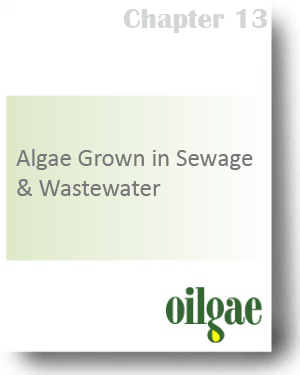Chapter XIII - Algae Grown in Sewage & Wastewater
This page provides details of the chapter XIII, from the Comprehensive Oilgae Report. You can purchase this chapter alone using the payment button provided below.
Introduction
One of the simplest and easiest methods to cultivate algae is to grow them in sewage and wastewater ponds. Algae grow best off of waste streams - agricultural, animal, or human. All over the world, municipalities and utilities spend enormous sums to treat wastewater and sewage and remove them of pollutants and impurities. Some of the pollutants in the wastewater and sewage are nutrients on which algae thrive. One another fact is that the algae that grow in human-sewage tend to have a lot of oil. This chapter deals with the methods, advantages and disadvantages of cultivating algae in sewage and wastewater to produce oil.
List of Contents
- Concepts
- Process
- Algae Strains that Grow Well in Sewage & Wastewater
- Prominent Companies Growing Algae in Wastewater
- Case Studies
- Challenges Associated with Growing Algae in Sewage
- Updates & Factoids
- Algae Cultivation in Sewage – Q&A
- Research & Experiments
- Sewage & Wastewater Reference
List of Tables
- Examples of Industries Employing Algae-Based Wastewater Treatment Technology
- Description of Algae Production from Poultry Waste
- Composition of Poultry Industry Wastewater
- Content of Selected Heavy Metals in a Sample Waste Water Treatment Plant
- Algal-Bacterial/Microalgal Consortia for Organic Pollutant Removal
- Theoretical Sewage & Wastewater Resource Potentials By 2020
List of Figures
- Process Schematic for Tertiary Wastewater Treatment with Microalgae
- Flowchart for Tertiary Wastewater Treatment with Microalgae
- Process Schematic for Tertiary Wastewater Treatment with Micro Algae
- A Schematic Diagram of a HRAP System
- High Rate Algal Pond Design
- IAPS system at the Environmental Biotechnology Research Unit stationed at the Grahamstown Municipal Sewerage works
- Typical Flow Sheet of Various Processes in Industrial Wastewater Treatment
- Process Schematic for Algae Production from Poultry Waste
- Cleansing Wastewater with Algae – Sintef Fisheries Irish Seaweed Centre Project
Key Takeaways from the chapter
- Algae can be cultivated in both industrial and municipal wastewater.
- Growing algae in wastewater provides the twin benefits of wastewater remediation and cost-effective biofuel production.
- Algae can be used to clean nutrient-laden, CO2-rich and low-oxygen water and turn it into oxygen-rich, CO2-low water as it flows back into the ecosystem, while simultaneously producing biomass for oil. This is the powerful idea that has driven companies to undertake serious efforts at growing algae in industrial wastewater and sewage.
- The overall economics for algae-based wastewater treatment are made more favorable when factoring the credits applicable for wastewater treatment.
- Research is still ongoing with regard to harvesting microalgae growing in sewage and industrial wastewater. In the last few years, a number of companies have started exploring this route for algae biofuels
- Key challenges include the availability of large amounts of waste water, prevention of contamination of desired strains, and cost-effective harvesting.
- Dissolved air flotation and filtration have shown some promise in the research done so far.
We are no more selling this report. |
|
No of Pages : 44 Last Updated : Dec 2011 Price : 200 US $ |
Related Chapters from the Section III – Processes & Challenges

